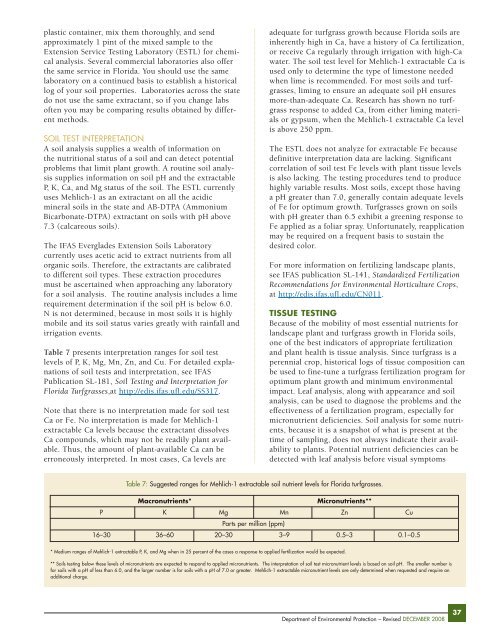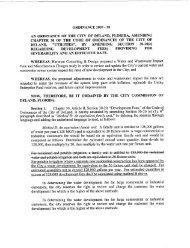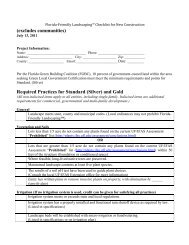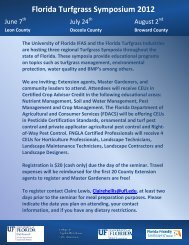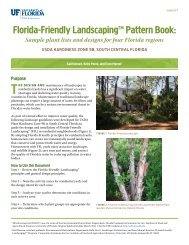Green Industries Best Management Practices manual
Green Industries Best Management Practices manual
Green Industries Best Management Practices manual
Create successful ePaper yourself
Turn your PDF publications into a flip-book with our unique Google optimized e-Paper software.
plastic container, mix them thoroughly, and sendapproximately 1 pint of the mixed sample to theExtension Service Testing Laboratory (ESTL) for chemicalanalysis. Several commercial laboratories also offerthe same service in Florida. You should use the samelaboratory on a continued basis to establish a historicallog of your soil properties. Laboratories across the statedo not use the same extractant, so if you change labsoften you may be comparing results obtained by differentmethods.SOIL TEST INTERPRETATIONA soil analysis supplies a wealth of information onthe nutritional status of a soil and can detect potentialproblems that limit plant growth. A routine soil analysissupplies information on soil pH and the extractableP, K, Ca, and Mg status of the soil. The ESTL currentlyuses Mehlich-1 as an extractant on all the acidicmineral soils in the state and AB-DTPA (AmmoniumBicarbonate-DTPA) extractant on soils with pH above7.3 (calcareous soils).The IFAS Everglades Extension Soils Laboratorycurrently uses acetic acid to extract nutrients from allorganic soils. Therefore, the extractants are calibratedto different soil types. These extraction proceduresmust be ascertained when approaching any laboratoryfor a soil analysis. The routine analysis includes a limerequirement determination if the soil pH is below 6.0.N is not determined, because in most soils it is highlymobile and its soil status varies greatly with rainfall andirrigation events.Table 7 presents interpretation ranges for soil testlevels of P, K, Mg, Mn, Zn, and Cu. For detailed explanationsof soil tests and interpretation, see IFASPublication SL-181, Soil Testing and Interpretation forFlorida Turfgrasses,at http://edis.ifas.ufl.edu/SS317.Note that there is no interpretation made for soil testCa or Fe. No interpretation is made for Mehlich-1extractable Ca levels because the extractant dissolvesCa compounds, which may not be readily plant available.Thus, the amount of plant-available Ca can beerroneously interpreted. In most cases, Ca levels areadequate for turfgrass growth because Florida soils areinherently high in Ca, have a history of Ca fertilization,or receive Ca regularly through irrigation with high-Cawater. The soil test level for Mehlich-1 extractable Ca isused only to determine the type of limestone neededwhen lime is recommended. For most soils and turfgrasses,liming to ensure an adequate soil pH ensuresmore-than-adequate Ca. Research has shown no turfgrassresponse to added Ca, from either liming materialsor gypsum, when the Mehlich-1 extractable Ca levelis above 250 ppm.The ESTL does not analyze for extractable Fe becausedefinitive interpretation data are lacking. Significantcorrelation of soil test Fe levels with plant tissue levelsis also lacking. The testing procedures tend to producehighly variable results. Most soils, except those havinga pH greater than 7.0, generally contain adequate levelsof Fe for optimum growth. Turfgrasses grown on soilswith pH greater than 6.5 exhibit a greening response toFe applied as a foliar spray. Unfortunately, reapplicationmay be required on a frequent basis to sustain thedesired color.For more information on fertilizing landscape plants,see IFAS publication SL-141, Standardized FertilizationRecommendations for Environmental Horticulture Crops,at http://edis.ifas.ufl.edu/CN011.TISSUE TESTINGBecause of the mobility of most essential nutrients forlandscape plant and turfgrass growth in Florida soils,one of the best indicators of appropriate fertilizationand plant health is tissue analysis. Since turfgrass is aperennial crop, historical logs of tissue composition canbe used to fine-tune a turfgrass fertilization program foroptimum plant growth and minimum environmentalimpact. Leaf analysis, along with appearance and soilanalysis, can be used to diagnose the problems and theeffectiveness of a fertilization program, especially formicronutrient deficiencies. Soil analysis for some nutrients,because it is a snapshot of what is present at thetime of sampling, does not always indicate their availabilityto plants. Potential nutrient deficiencies can bedetected with leaf analysis before visual symptomsTable 7: Suggested ranges for Mehlich-1 extractable soil nutrient levels for Florida turfgrasses.Macronutrients*Micronutrients**P K Mg Mn Zn CuParts per million (ppm)16–30 36–60 20–30 3–9 0.5–3 0.1–0.5* Medium ranges of Mehlich-1 extractable P, K, and Mg when in 25 percent of the cases a response to applied fertilization would be expected.** Soils testing below these levels of micronutrients are expected to respond to applied micronutrients. The interpretation of soil test micronutrient levels is based on soil pH. The smaller number isfor soils with a pH of less than 6.0, and the larger number is for soils with a pH of 7.0 or greater. Mehlich-1 extractable micronutrient levels are only determined when requested and require anadditional charge.Department of Environmental Protection – Revised DECEMBER 200837


